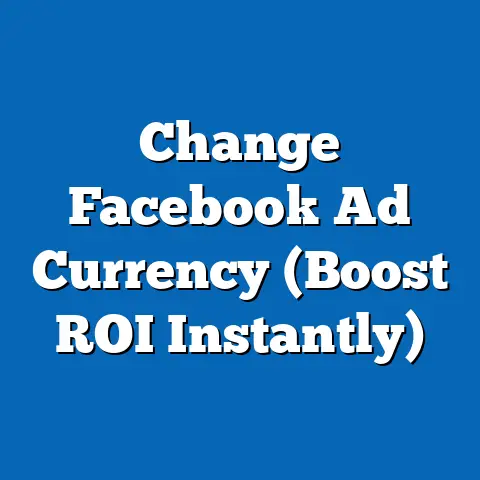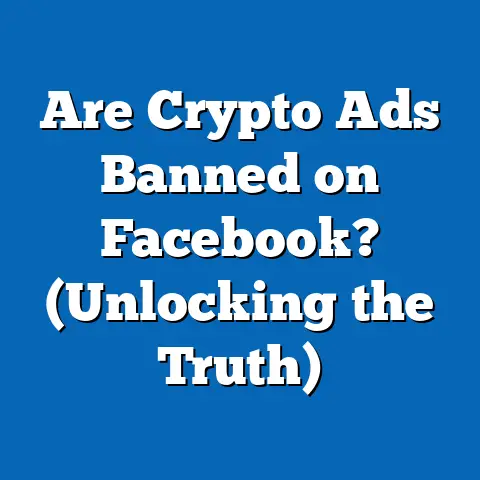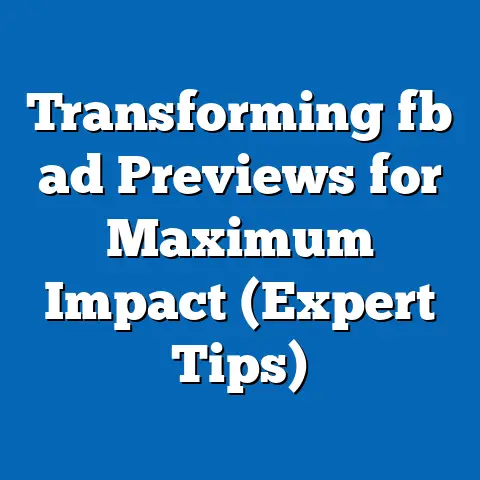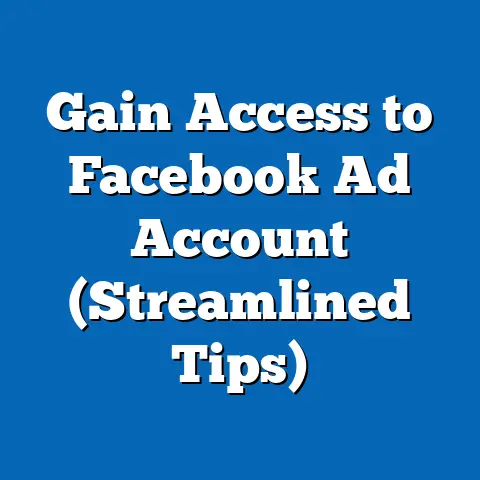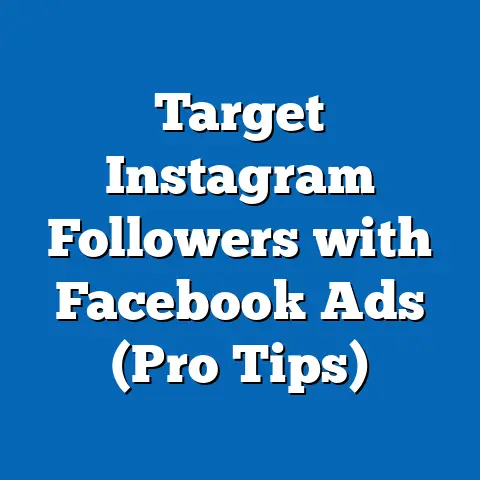Do Facebook Ads Really Cost Money? (Uncover Hidden Truths)
It’s a question I hear all the time: “Are Facebook Ads really worth the money?” On the surface, it seems simple. You set a budget, create an ad, and watch the results roll in, right? Well, not exactly. While Facebook Ads can be incredibly powerful, the truth is that they cost far more than just the dollars you spend on ad placements. There are hidden costs, both financial and non-financial, that can significantly impact your return on investment (ROI). In this article, I’m going to pull back the curtain and reveal the hidden truths about the real costs of Facebook Ads, so you can make informed decisions and maximize your advertising efforts.
Expert Picks on the Costs of Facebook Ads
To get a well-rounded perspective, I’ve looked to some leading voices in the digital marketing world to understand their take on Facebook Ads costs. Their insights highlight the multi-faceted nature of the investment required.
Neil Patel, a renowned digital marketing guru, often emphasizes the importance of understanding the lifetime value of a customer when evaluating ad spend. He points out that while the initial cost per acquisition might seem high, the long-term revenue generated by a loyal customer makes Facebook Ads a worthwhile investment. “Don’t just look at the immediate cost,” he advises. “Focus on the long game and how Facebook Ads can contribute to your overall business growth.”
Amy Porterfield, a social media marketing expert, stresses the significance of strategic planning and audience targeting. In her podcast episodes, she often discusses how poorly defined targeting can lead to wasted ad spend. “You can throw money at Facebook Ads all day long, but if you’re not reaching the right people, you’re essentially throwing it away,” she warns. She advocates for investing in thorough audience research and A/B testing to optimize ad performance.
Gary Vaynerchuk, a prominent entrepreneur and social media influencer, offers a more blunt perspective. He believes that while Facebook Ads can be effective, they require constant attention and optimization. “It’s not a set-it-and-forget-it strategy,” he insists. “You need to be actively monitoring your campaigns, analyzing the data, and making adjustments to get the best results.” He acknowledges the time commitment involved in managing Facebook Ads effectively.
These expert opinions highlight a crucial point: the cost of Facebook Ads extends beyond the monetary investment. It also includes the time, effort, and expertise required to run successful campaigns. Each expert, drawing from their unique experiences, underscores the importance of strategic planning, audience targeting, and ongoing optimization to maximize ROI.
Direct Costs of Facebook Ads
Let’s get down to brass tacks. The most obvious cost of Facebook Ads is, well, the money you spend on them. But even this seemingly straightforward aspect has complexities. The way Facebook Ads are priced is primarily through an auction system, where advertisers bid against each other to display their ads to specific audiences. This bidding process influences the direct costs you’ll encounter, which are typically measured in three main ways:
- Cost per Click (CPC): This is the amount you pay each time someone clicks on your ad. CPC is ideal if your goal is to drive traffic to your website or landing page.
- Cost per Thousand Impressions (CPM): This is the amount you pay for every 1,000 times your ad is displayed, regardless of whether people click on it. CPM is effective for brand awareness campaigns where visibility is the primary goal.
- Cost per Action (CPA): This is the amount you pay for a specific action taken by a user, such as signing up for a newsletter, downloading a resource, or making a purchase. CPA is suitable for campaigns focused on driving conversions.
The actual costs you’ll incur depend on several factors, including your target audience, the competitiveness of your industry, and the quality of your ads. For example, targeting a highly sought-after demographic in a competitive niche will likely result in higher CPC and CPM rates.
To give you a general idea, here are some typical cost ranges businesses might encounter:
- CPC: $0.50 to $2.00 or more, depending on the industry and target audience.
- CPM: $5 to $20 or more, depending on the industry and target audience.
- CPA: This can vary widely depending on the complexity of the desired action and the effectiveness of your ad campaign.
Keep in mind that these are just averages, and your actual costs may be higher or lower depending on your specific circumstances. For example, I once ran a campaign for a local bakery targeting users interested in cake decorating. The CPC was relatively low, around $0.75, because the competition was less intense. However, when I worked with a tech startup targeting venture capitalists, the CPC soared to over $5 due to the high demand for that audience.
Takeaway: Understanding the direct costs of Facebook Ads is crucial, but it’s just the tip of the iceberg. The auction system, target audience, and ad quality all play a role in determining how much you’ll pay.
Hidden Costs Beyond Monetary Investment
This is where things get interesting. While the direct costs are easily quantifiable, the hidden costs are often overlooked but can significantly impact your overall ROI. These hidden costs primarily revolve around time, resources, and expertise.
-
Time Investment: Creating and managing effective Facebook Ad campaigns is not a passive activity. It requires a significant time investment. This includes:
- Planning: Defining your target audience, setting campaign goals, and developing a strategic approach.
- Ad Creation: Writing compelling ad copy, designing visually appealing graphics or videos, and crafting engaging headlines.
- Campaign Management: Monitoring ad performance, analyzing data, making adjustments to targeting, bidding, and ad creative.
- Reporting: Tracking key metrics, generating reports, and communicating results to stakeholders.
-
Human Resources: To run successful Facebook Ad campaigns, you need skilled personnel with expertise in various areas:
-
Copywriters: To write persuasive ad copy that resonates with your target audience.
- Graphic Designers/Video Editors: To create visually appealing ads that capture attention and convey your message effectively.
- Data Analysts: To analyze campaign data, identify trends, and provide insights for optimization.
- Campaign Managers: To oversee the entire ad campaign, ensuring it aligns with your business goals and objectives.
Time Investment: Creating and managing effective Facebook Ad campaigns is not a passive activity. It requires a significant time investment. This includes:
- Planning: Defining your target audience, setting campaign goals, and developing a strategic approach.
- Ad Creation: Writing compelling ad copy, designing visually appealing graphics or videos, and crafting engaging headlines.
- Campaign Management: Monitoring ad performance, analyzing data, making adjustments to targeting, bidding, and ad creative.
- Reporting: Tracking key metrics, generating reports, and communicating results to stakeholders.
-
Human Resources: To run successful Facebook Ad campaigns, you need skilled personnel with expertise in various areas:
-
Copywriters: To write persuasive ad copy that resonates with your target audience.
- Graphic Designers/Video Editors: To create visually appealing ads that capture attention and convey your message effectively.
- Data Analysts: To analyze campaign data, identify trends, and provide insights for optimization.
- Campaign Managers: To oversee the entire ad campaign, ensuring it aligns with your business goals and objectives.
Human Resources: To run successful Facebook Ad campaigns, you need skilled personnel with expertise in various areas:
Copywriters: To write persuasive ad copy that resonates with your target audience.
If you don’t have these skills in-house, you’ll need to hire freelancers or agencies, which adds to the overall cost of your Facebook Ads strategy. Even if you handle some of these tasks yourself, the time you spend on them has a cost – it’s time you could be spending on other aspects of your business.
I remember when I first started running Facebook Ads for my own business, I underestimated the time commitment involved. I thought I could just throw up a few ads and watch the leads roll in. Boy, was I wrong! I quickly realized that creating effective ad campaigns required a lot of research, testing, and optimization. I ended up spending hours each week tweaking my ads, analyzing data, and making adjustments. While I eventually got better at it, the initial time investment was significant.
Takeaway: Don’t underestimate the hidden costs of Facebook Ads. Time, resources, and expertise are all essential ingredients for success. If you lack these resources, you’ll need to factor in the cost of hiring freelancers or agencies.
The Cost of Ineffective Advertising
Now, let’s talk about the real pain: the cost of running bad Facebook Ads. This isn’t just about wasted ad spend; it’s about missed opportunities, damaged brand reputation, and a whole lot of frustration.
Common pitfalls that lead to ineffective advertising include:
- Targeting the Wrong Audience: This is perhaps the most common mistake. If you’re showing your ads to people who aren’t interested in your products or services, you’re essentially throwing money away.
- Ineffective Ad Copy: Your ad copy needs to be clear, concise, and compelling. If it’s boring, confusing, or irrelevant, people won’t click on it.
- Poor Visuals: In today’s visually driven world, your ads need to be visually appealing. Blurry images, low-quality videos, and uninspired designs will turn people off.
- Lack of A/B Testing: A/B testing involves creating multiple versions of your ads and testing them against each other to see which performs best. If you’re not A/B testing, you’re missing out on valuable insights that can help you optimize your campaigns.
- Ignoring Data: Facebook Ads Manager provides a wealth of data about your ad performance. If you’re not analyzing this data and using it to make informed decisions, you’re flying blind.
The financial implications of these mistakes can be significant. Studies have shown that businesses waste an average of 26% of their ad spend due to poor targeting. That’s a huge amount of money that could be better spent on more effective strategies.
I once worked with a client who was convinced that Facebook Ads didn’t work. They had tried running ads in the past but had seen little to no results. When I looked at their previous campaigns, I quickly realized that they were making several of the mistakes I mentioned above. They were targeting a broad audience with generic ad copy and uninspired visuals. They hadn’t done any A/B testing and weren’t tracking their results. It was no surprise that their campaigns had failed.
By implementing a more strategic approach, including targeted audience research, compelling ad copy, visually appealing creatives, and rigorous A/B testing, we were able to turn their Facebook Ads performance around.
Takeaway: Ineffective advertising is a costly mistake. Avoid common pitfalls by investing in proper planning, targeting, ad creation, and data analysis. Ongoing optimization and learning are essential for mitigating risks and maximizing ROI.
Long-Term Value vs. Short-Term Costs
Okay, so we’ve established that Facebook Ads do indeed cost money, and that the true costs extend far beyond the initial financial investment. But here’s the thing: despite these costs, Facebook Ads can still be an incredibly valuable tool for businesses of all sizes. The key is to focus on the long-term value rather than just the short-term costs.
Facebook Ads offer a unique opportunity to:
- Reach a Large and Targeted Audience: With over 2.9 billion monthly active users, Facebook provides access to a massive audience. And with its sophisticated targeting options, you can reach the specific people who are most likely to be interested in your products or services.
- Build Brand Awareness: Even if people don’t immediately click on your ads or make a purchase, seeing your brand repeatedly can increase awareness and familiarity. This can lead to future sales down the line.
- Generate Leads: Facebook Ads can be used to generate leads by directing users to landing pages where they can sign up for your newsletter, download a free resource, or request a consultation.
- Drive Sales: With the right targeting and ad creative, Facebook Ads can be a powerful tool for driving sales. You can create ads that showcase your products or services, highlight special offers, and encourage people to make a purchase.
- Engage with Customers: Facebook Ads can be used to engage with your existing customers by sharing valuable content, promoting events, and running contests. This can help strengthen relationships and build loyalty.
Many businesses have successfully leveraged Facebook Ads for sustained growth. For example, Dollar Shave Club used Facebook Ads to disrupt the razor industry by offering affordable razors delivered directly to customers’ doors. They created humorous and engaging video ads that went viral, driving massive brand awareness and sales.
Another example is Warby Parker, an online eyewear retailer, used Facebook Ads to target users interested in fashion and design. They created visually appealing ads that showcased their stylish glasses and offered a convenient online shopping experience. This helped them build a loyal customer base and become a major player in the eyewear industry.
I’ve seen firsthand how Facebook Ads can transform businesses. I worked with a small local business that struggled to attract new customers. By implementing a strategic Facebook Ads campaign, we were able to reach a wider audience, generate leads, and drive sales. Within a few months, their business had grown significantly.
Takeaway: View Facebook Ads as an investment in your business’s long-term growth. Focus on the potential for brand awareness, customer engagement, and lead generation.
Conclusion
So, do Facebook Ads really cost money? Absolutely. But the true costs extend far beyond the initial financial expenditure. They include the time, resources, and expertise required to run successful campaigns. They also include the potential losses incurred from ineffective advertising.
However, despite these costs, Facebook Ads can be an incredibly valuable tool for businesses of all sizes. The key is to understand the hidden truths about the real costs of Facebook Ads and to approach them strategically. By investing in proper planning, targeting, ad creation, and data analysis, you can maximize your ROI and achieve your business goals.
Now, I want to leave you with a thought-provoking question: Are you ready to invest the time, effort, and resources required to unlock the full potential of Facebook Ads?
Call to Action
I’d love to hear about your experiences with Facebook Ads. What hidden costs have you encountered? What strategies have you found to be most effective? Share your thoughts in the comments section below! Let’s learn from each other and help each other succeed in the ever-evolving world of Facebook advertising.

